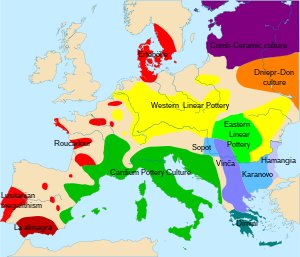Almería culture

The Almería culture is a late Neolithic Iberian agricultural culture that is named after the coastal town of Almería in southeast Spain . Its late phase shows the influence of the Copper Age and points to relationships with the bell beaker culture. The successor to the Almería culture is the Los Millares culture .
This culture differs fundamentally from northern Spain. It is more related to the prehistory of the Maghreb . At the beginning of the 20th century, the French philologist and archaeologist Louis-Pierre Siret equated the producers of Neolithic finds in south-eastern Spain and North Africa with the Iberians , presumably based on information from Varros .
Periods and sites

The beginning of the archaeological culture (around 3000 BC ) formed the permanent places in the basin of Vera (Cabecicos Negros), on the Campo de Tabernas, the Campo de Nijar, in the valley of the Andarax, in the corridor of Chirivel and in the north at Vélez. The excavation of the settlements on the Cerro de la Chinchilla near Rioja and on the Cerro de los López near Vélez-Rubio yielded the essential knowledge about the early stage. This period continues the system of older villages, but they are expanded.
The culture then evolves to the first phase of Iberian copper metallurgy, identified in the upper strata of some places such as Almizaraque (Almanzora Caves), Ciavieja (El Ejido) and Terrera Vertura.
features
The technological classification of the culture depends on the development period, while the ceramic inventories remain similar. The Silextechnologie shows in many places microlith repertoire.
The dead are buried in collective graves, first in earth graves, then in dome and round graves. In addition to aniconical menhirs , ivory figures (Jaén) and flat stone idols appear in the graves. They show a certain range of variation, but no stylistic shape.
The Almería culture also produced rock and stone carvings ( petroglyphs ), especially eye idols . These petroglyphs have their clearest counterpart outside of Spain in the south tomb on the Holm of Papa Westray .
literature
- Manuel Carrilero Millán, Ángela Suárez Marquez: El territorio almeriense en la prehistoria . IEA, Almería, 1997, ISBN 84-8108-134-5